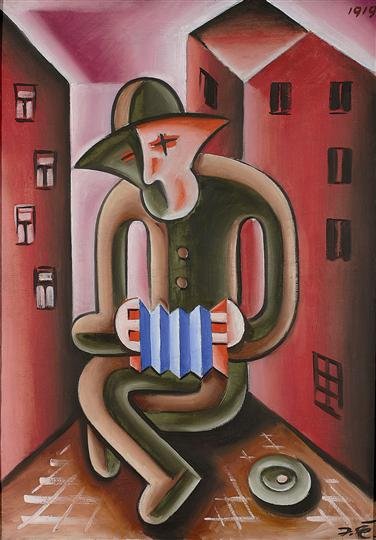Description
The work "harmonika?" (Harmoniká?) Of Josef? Avel, created in 1919, represents a fascinating example of the uniqueness of Czech art of the early twentieth century. As one of the main representatives of the cubist movement in his country,? Ashar achieves in this piece, join the pictorial tradition with modern sensitivity, reflecting both the essence of human interactions and the social environment of the time.
At first glance, the painting focuses on a character that occurs after an accordion, an emblematic instrument in popular music that symbolizes the art of interpretation and emotional connection with the public. The figure of the harmonicist is presented in a stylized way, with geometric shapes that suggest a cubist treatment. Facial features are barely insinuated, which reflects the tendency to abstract the human form to focus on the universality of being. Through this representation, the artist seems to look for a fusion between the individual and his context, suggesting that each note of the accordion intertwines with life itself.
The color in "harmonika?" It stands out for its balanced palette, where ocher, brown and blue tones predominate. These shades, far from being arbitrary, evoke a feeling of nostalgia and melancholy that could be associated with the postwar period, a time in which the work was created. The use of shadows and lights adds depth to the canvas, allowing the viewer to immerse the musical atmosphere that the image proposes, turning painting into both visual and emotional experience.
The composition of the work is remarkably balanced. The figure of the harmonicist is integrated in a background that is perceived almost as an echo of its musical notes, creating a symbiosis between the subject and its environment. Each element, each color, is articulated to address the viewer's attention, guiding it through a narrative that does not require words. This connection between art and music is a recurring theme in the work of? Avel, who found in musical harmony a parallel with visual harmony.
In a broader context, "harmonika?" It reflects cultural changes in Europe during the years after World War. The influence of Cubism on the work of? Avel is inscribed in a broader movement that sought to break the past traditions and explore new representations of reality. Likewise, his work is aligned with the search for a genuine modernity, which is both anchored in the folklore roots and in the challenges of the new century.
Josef? Avel's work, including "harmonika?" . In this sense, the harmonist becomes not only an interpreter of the music, but a symbol of all those struggles and hopes that resonate in the human heart, a legacy that transcends his time and space, and that continues to reverberate today . The work of? Ashk is supported as a testimony of the ability of art to capture the essence of life in its multiple dimensions, inviting each spectator to find their own melody within the canvas.
KUADROS ©, a famous paint on your wall.
Hand-made oil painting reproductions, with the quality of professional artists and the distinctive seal of KUADROS ©.
Art reproduction service with satisfaction guarantee. If you are not completely satisfied with the replica of your painting, we refund your money 100%.

